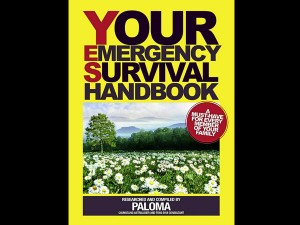
In these times of climate change, you never really know what’s going to happen next. Nature can be so unpredictable we can be caught offguard and rendered powerless before its fury.
How to survive nature’s wrath and other unforeseen catastrophes? For a start, get a copy of “Your Emergency Survival Handbook” from Anvil Publishing.
A compilation of very practical tips and timely reminders on how to prepare for any kind of eventuality, the “YES Handbook” was researched and compiled by astrologer and feng shui consultant Paloma and deals with real-life situations in an intelligent and organized manner. Here are some excerpts:
Steps to awareness
Determine how each kind of disaster threatens you, your safety and survival. These will give you the parameters necessary for planning.
1. Buy a pocket-sized notebook (that you can easily stash in your bag or the glove compartment of your car). In it, jot down notes – i.e., lists, special instructions, important numbers – don’t rely on your PC or laptop always being there.
2. Get familiar with your location. Learn to read a map and look what’s within a two-kilometer, five-, 10-, 25-, and 50-kilometer radius of your home and place of work.
Steps to safety
1. Ideally, contact the National Disaster and Risk Reduction Management Council (NDRRMC), your local Red Cross chapter, or any other emergency management office (i.e. Emergency Research Center, Inc.) – and be prepared to take notes.
2. Check on all types of disasters that can happen and file information on how to prepare for each.
3. If you have a supportive community, agree on a warning signal: what it sounds like and what you should do when you hear it.
4. Find out the best and easiest way to help children, pregnant women, the elderly or disabled persons, if needed.
5. Encourage disaster management plans at your workplace, your children’s schools, and other places where your family spends time.
Your basic family evacuation kit
Every family should have a sturdy case, crate, or box containing these items on hand all the time. Don’t wait for a fire, a disaster or an evacuation to hit. Put together one now.
1. Water. A three-day supply; one gallon per person per day.
2. Food. A three-day supply of non-perishable, easy-to-prepare food. Dried foods require no preparation.
3. At least two flashlights (one big, one regular-sized)
4. Battery-powered or hand-cranked radio
5. Extra batteries
6. First aid kit containing, among others, your medications (three-month supply of personal prescription medicines), and other personal medical items in a plastic resealable bag (marked with your name, age, blood type, allergies, and other medical conditions)
7. Multi-purpose tool, such as a Swiss knife or pocket survival tool
8. Sanitation and personal hygiene items
9. Copies of personal documents (e.g., medication list and pertinent medical information, proof of address, deed/lease to home, passports, birth certificates, insurance). Make digital copies and store them on the Internet. Free mail such as Yahoo or Gmail may be used if you do not have a domain server. Just make sure the passwords are strong and secure.
10. Cell phones with chargers
11. Family and emergency contact information
12. Extra cash
13. Other essential items that cannot be replaced if destroyed or damaged.
Floods
Floods are the most common and widespread of all natural hazards (in the country). Some floods develop over a period of days, but flash floods result from raging waters in just a few minutes due to our faulty drainage system and poor garbage management. Even with weak rainfall, flash floods can occur and carry rocks, mud, and other debris with them. Be especially aware of this if you live in a low-lying area, downstream or near water.
Before and during a flood:
1. Tune in to the radio for updates and information.
2. Identify drainage channels, creeks, rivers, dams, etc. in your area and determine whether they pose a hazard.
3. Be aware of flash floods. If there is any possibility of a flash flood occurring, move immediately to higher ground. Do not wait for instructions to move.
4. The minute water enters your main door, turn off utilities at the main switches and valves. Disconnect electrical appliances, but do not touch electrical equipment if you are wet or standing in water.
5. Fill your swimming pool or bathtub (if you have one) and/or big pails/drums with water in case water becomes contaminated or services are cut off. Preferably, have at least one portable water purifying system on hand.
6. If local authorities issue a flood watch, prepare to evacuate. Learn your community’s flood evacuation routes and where to find high ground.
7. Determine how you would care for family members who may be living elsewhere but might need your help in a flood. Determine any special needs your neighbors might have.
8. Keep a stock of food and extra drinking water.
9. If you need to evacuate, grab your individual disaster supplies kit and go!
After a flood:
1. Stay away from floodwaters. Water may be contaminated by oil, gasoline, raw sewage, or worst, the urine and feces of contaminated pests that can lead to the much-dreaded leptospirosis. It may also be electrically charged from underground or downed power lines.
2. Stay away from moving water. Even moving water only six inches deep can sweep you or children off your feet. If you must walk in a flooded area, try to walk where the water is not moving. Use a stick to check the depth and firmness of the ground in front of you.
3. Do not drive into flooded areas. If floodwaters rise around your car, abandon the car and move to higher ground, if you can still do so safely. You and your vehicle can be quickly swept away as floodwaters rise. We’ve all seen this happen in movies, documentaries, and news clips!
4. Be aware of areas where floodwaters have receded. Roads may have weakened –considering how our roads are paved here – and could collapse under the weight of your car.
5. Stay away from downed power lines and report them to the power company.
6. Stay away from disaster areas unless you are an official volunteer of a disaster relief organization. Should you want to help, one way is to give money to a reputable group. Do not donate food, clothing or other personal items unless these are specifically requested.
7. Continue listening to the radio for information about where to get assistance for temporary shelter, clothing, and food. Find out if there are outreach programs close to you that are available to help you cope with the stress of the situation.
8. Wash your hands frequently with soap and clean water if you come in contact with floodwaters. Throw away food that has come in contact with floodwaters. Listen for news reports to learn whether the community’s water supply is safe to drink.
Your home earthquake plan
1. Eliminate hazards by bolting bookcases, china cabinets, and other tall furniture and water heaters to wall studs, and installing strong latches on cupboards.
2. Consult a professional to find out additonal ways to protect your home, such as bolting the house to its foundation and other structural mitigation techniques.
3. Keep essentials like a flashlight and sturdy rubber shoes by your bedside.
4. Teach children EDITH. (Exit Drills in the Home) and drill them at least every quarter. (For details, visit https://www.ehow.com/ how_14115_practice-exit-drills.html)
5. Form a group within your community and take a first aid class. Keep your training current.
6. Include training on how to use fire extinguishers.
7. Inform household maids and caregivers of your plan.
8. Identify and choose a safe place in every room—beside a sturdy table or desk that forms an A-frame, or against an inside wall where nothing can fall on you. •
“Your Emergency Survival Handbook” is available at leading bookstores.














































